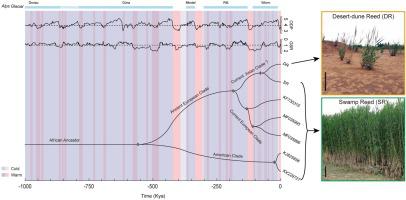Aquatic Botany ( IF 1.8 ) Pub Date : 2021-01-02 , DOI: 10.1016/j.aquabot.2020.103349 Tianhang Qiu , Suxia Cui

|
Phragmites australis, a Poaceae species distributed worldwide, has strong environmental adaptability and easily forms ecotypes. To study the process of ecotypic evolution of P. australis, we used two sympatric ecotypes with obvious phenotypic differences—Swamp Reed (SR) and Desert-dune Reed (DR) from the Hexi corridor of China as materials, and estimated divergence times derived from chloroplast genome sequencing. Their plastomes were very similar, with a sizes of 137,660 bp (SR) and 137,647 bp (DR). The results of multiple comparison methods revealed only 13 differences between them, most of which were in non-coding regions. A Poaceae chronogram was reconstructed from Bayesian inference using five fossil records. We optimized this analysis by exploring the input datasets, the fossil records, and the test model to get an estimated ecotypic divergence time of 73 Kya. Two main branches in the evolution of P. australis were outstanding: the American lineage and the European lineage. SR/DR came from the late expansion of the European lineage and separated during the Last glacial period (11.5–80 kya). The intense environmental changes in Quaternary likely caused genetic diversity accumulation, which became the driving force for the DR formation. Our estimated divergence time approach for Phragmites ecotypes will help to explore the phylogenetic status and environmental adaption process of polyploid taxa within Poaceae.


























 京公网安备 11010802027423号
京公网安备 11010802027423号